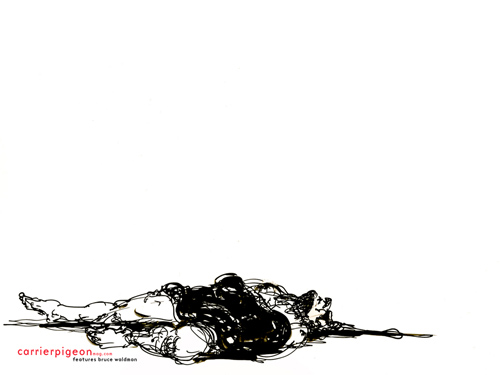No matter your personal feelings about Norman Rockwell, the guy was as obsessive a painter as anyone has ever been, especially considering the constraints inherent to the illustration game. On first appearance it seems as though he was content to paint ads for bread and tires and whatever else came along at the right price. And from the perspective of an illustrator in 2011, having the time to draw several fully-rendered studies before painting a 36-inch-tall finish in oil is a little mind-boggling.
But consider this: in the early 1960s he secretly entered a knock-off of a Jackson Pollock abstract into an art contest. He'd painted it in preparation for the final rendering of a drip painting featured as part of an illustration for a 1962
Saturday Evening Post cover, which you can see here.
He won first place. It must have been bittersweet to win over the fine-art establishment with a knock-off that, incidentally, had been entered under an Italian name, when a true Rockwell artwork, prominently signed and slaved over, couldn't get him in the front door of a gallery.
Sure, Rockwell primarily painted cheeseball, watering holes and puppies. We all get boxed into what people come to expect, and then demand, from our first successes. But he would have painted anything, tried anything. That, more than his apple-pie ornamented paychecks, is what makes him relatable now.
People took notice of Rockwell's toe dipping into modernism, and a magazine called
Ramparts called him up with an unprecedented proposal. The slick, left-leaning publication, which published Che Guevara's diaries and trained staffers who in turn created other slick, left-leaning publications, such as
Rolling Stone, (which is still, at least, treading water with admirable stamina) had an idea for Rockwell to create a
"Saturday Evening Post style cover," then do some acid and paint it over again. It's really not surprising that this appealed to the Boy Scout of American illustrators: Rockwell's obsession with his work is well-documented. In his autobiography he describes the steps he took to curb his habit of overworking the heads of his subjects, occasionally painting drunk and even going so far as to paint with oversized brushes, then bricks, then half-shingles. Of the leftist magazine's pitch Rockwell said, "I thought it might be fun." But a concerned psychologist friend intervened, and the commission never happened.
The point is that illustrators are in the same boat we've always been in, stumping around at the mercy of art directors and editors and a branding perspective on the public readership. On Friday, April 1,
Carrier Pigeon celebrated the closing of its issue no. 2 release exhibition at
Sacred Gallery in front of a gratifying number of new faces. Among things worth celebrating is confirmation that a magazine where every artist and author has final say on his/her contribution—contributions, in this case, being synonymous with personal work—is not just a one-hit wonder. If you were a part of this event, we thank you. A special thank you also goes out to the authors who participated by publicly reading from their stories: Russ Spitkovsky, Ben Schaeffer and Matthew Blair.
If you missed the event, don't worry.
Carrier Pigeon is printed quarterly. Keep your calendars open.



















